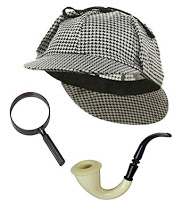
What would Sherlock Holmes do with the Bella in the Wych Elm case? Had he handled the case in 1943 when the body was first discovered, I am confident he would have used his exquisite powers of deduction to eliminate the impossible and identify the solution, no matter how improbable it seemed. Alas… Sherlock Holmes is a mere fictional character but… knowing his modus operandi, I would tend to think that he would have tracked down the facts of the case. But, at this point, almost 75 years after the discovery of Bella’s skeleton in the Wych Elm, the facts of the case are clouded by rumours, innuendos, assumptions, fallacies, inaccuracies and errors. I am no Sherlock but… I do tend to find it most annoying when people ignore the obvious facts, add to the rumours or perpetuate the inaccuracies. Is the mystery of Bella solvable? Perhaps not… but I do believe that some theories can be explored in more detail with a view to determining if they are “impossible” or simply “improbable”.
With that in mind, let us put on our collective deerstalker hats, clench our meerschaum pipes in our teeth and have a closer look at a few of the pivotal clues in the case. Before we begin, much of what is to follow is based on the West Mercia Police files that deal with the Hagley Wood murder (a.k.a. Bella in the Wych Elm). The files were released to the Worcestershire Archives and are available for purchase. The conditions of release are rather narrow and I am therefore not going to be able to share full document images. We are therefore stuck with my own transcripts of the relevant documents. I have included the document references as provided by the Worcestershire Archives.
Anna of Claverley
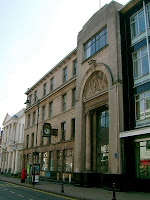
Anyone familiar with the case knows that in the fall of 1953, an Express and Star columnist, Lt. Col. Wilfred Byford-Jones, using the nom-de-plume of Quaestor, wrote a series of sensationalist articles about the Hagley Wood murder.
A woman calling herself Anna, with a return address in Claverley, wrote a letter to Quaestor on November 18, 1953. The contents of the letter have been reprinted numerous times and run thusly:
Nov 18, 1953
My dear Quaestor,
Finish your articles re: the Wych Elm crime by all mean, they are interesting to your readers, but you will never solve the mystery.
The one person who could give the answer is now beyond the jurisdiction of earthly courts, the affair is closed and involves no witches, black magic or moon light rites.
Much as I hate having to use a nom-de-plume I think you would appreciate if you knew me.
The only clues I can give you are that the person responsible for the crime died insane in 1942 and the victim was Dutch and arrived illegally in England about 1941. I have no wish to recall any more.
[there is a last paragraph which references a “mutual friend” that, according to the police files and Quaestor, has nothing to do with the Hagley Wood murder. It has been scribbled out by pencil and is difficult to decipher. The Worcestershire Archives blog has images of both pages of this letter, for those interested in deciphering the last paragraph.]
Anna
On November 21, the editor of the Express & Star, B.E. Whiteaker sent Anna’s letter to S. Inight, the Asst. Chief Constable, Count Police Headquarters, Worcester. The police were naturally quite interested in the letter and appealed to Anna to step forward. On December 3, 1953, Anna finally sent another letter to Quaestor, which read as follows:
3-XII-53
Dear Quaestor,
Had so much publicity not been given to ‘Anna’ I would have contacted you before.
I will meet you and officers of the Worcestershire C.I.D. at the Dick Whittington (it is beyond The “Stewponey” from Wolverhampton) tomorrow night (Friday) at about 8:30 p.m. and maybe I can help them with their investigations if they are still interested, subject to my conditions to which I think they will agree. You of course, will not advertise this meeting in your press.
At the Whittington they have a bar on the left of the entrance called the “priest’s hole”.
Anna
Anna meets the Police
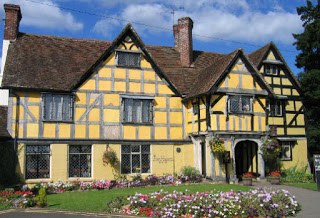
There is, unfortunately, no clear record in the West Mercia Police files of what transpired in the Whittington Pub on the night of December 4, 1953. All we have to go on is a newspaper article written by Quaestor on January 16, 1958. He had been sworn to secrecy by the police but, after seeing an interview with the pathologist on ITV, who stated that the woman had been identified, Quaestor felt free to tell the tale of the meeting with Anna from Claverley.
I have made a few notes [italics in square brackets] where the errors are too glaringly obvious not to mention.
It was late in April 1943, that the remains of Bella were found by three youths [there were four youth] in a hollow tree in Hagley Wood. A picture of what the girl had been like was soon built up by a pathologist and the robot figure he created told the police much—but not her name and address and the secret of her death.
No indication that either of these mysteries had been solved was given until recently, when a pathologist said of Bella in an I.T.V. programme: “After extensive inquiries by the superintendent (Detective Superintendent T. Williams, of Worcestershire C.I.D.) he was able to identify her. It was a classic piece of detection.”
So now a pledge I made to keep secret further facts of the death of Bella in the Wych Elm is purged, I can tell of my dramatic meeting with a woman who claimed to know how Bella died. It began with the receipt by me of a letter from a writer who signed herself Anna. It was marked urgent and gave what purported to be some of the facts of the murder. It is to these facts that the pathologist referred as the solution.
After the first I appealed to her through the Express and Star to meet me to discuss the crime.
It was obvious that she was afraid to do this since the facts she had given involved a relative. She said he was present when Bella, or to give her her full name, Lubella, died in what the writer knew as a bluebell wood. It was not until ten days later that “Anna” wrote again. She fixed a rendezvous in a way that could not have been more melodramatic if it had been written in a Dorothy L. Sayers detective story.
The place of the meeting was arranged in the Monk’s room at the Dick Whittington Inn, Kinver, at 8 o’clock one dark rainy night. No clue was given in the letter of how I should know “Anna”. She did not describe herself. All she said was “You will know me when you see me.”
Outside the inn I met Detective Superintendent Williams, a girl detective and a male detective shorthand writer. Singly we went into the Monk’s room, a quiet cell like place off the left of the corridor that led from the mitred back door.
Then a girl entered. She was tall and curvaceous and blonde. Her clothes were fashionable. She looked in astonishment when she saw three people [not four? three detectives and Quaestor] sitting expectantly, and without a word between them, in a quiet corner of the otherwise empty chamber.
She mounted a staircase, still looking at us curiously, but without a word or sign.
In ten minutes at least 20 girls entered, mounted the staircase, then descended and left.
All of them looked at us, it seemed, with apprehension and bewilderment.
Then I set off to investigate and I found that the stairs led to the ladies’ toilet.
The little earnest group of sleuths were too tense to see the humour of the situation.
All we knew was that one of the dozen girls had been Anna. The question was which?
Taking separate routes, the chief, the girl detective and I converged on the long bar in a room reached by descending several steps at the end of the corridor outside.
Here we searched among the female faces for a guilty or a knowing look.
Chief Detective Williams, one of the smartest men in his line, found that he was converging on the same woman as I. She looked quickly first at me, then at him. Then she began to talk rapidly to a well dressed man who accompanied her. I did not hesitate.
The chief heard me say “Anna, I believe?” She caught her breath, nodded to her companion. “I’ll follow you back to the monk’s room,” she said. She and her companions [more than one? we only know of the well-dressed man] joined us five minutes later.
There followed for me, and I think, for the detectives, a fascinating half hour.
Anna gave us her name and address.
Speaking with great solemnity she told us that she had for ten years guarded her story with great secrecy. Only one person, her husband, who accompanied her, knew the story she was about to tell. No one else would ever have heard of it but for the fact that I had reopened the case. The details given, the new revelations made, had deprived her of sleep.
Then she told us her dramatic story, answering satisfactorily questions asked her without warning to check her grip on the facts. She gave us the name and address of an officer.
He had come to her one night in late April, 1943 [Bella was discovered in April 1943, not killed on that date]—in fact, on a day which was consistent with the expert assessment of the day of Bella’s death—and told her that something terrible had happened to him.
He confessed to her under secrecy that he had been with a friend, a male trapeze artist then appearing at [indecipherable word] Hippodrome, and a Dutchman, in a car.
The officer was driving it. Between the other two men in the back was Bella. Suddenly as the car was descending Mucklow-hill, Halesowen, something happened. The girl seemed to have collapsed. The officer stopped the car. The two men then told him to drive on. “She’s dead,” they told him curtly. The order to drive on was repeated, far more peremptorily than before.
The car was driven through the blacked out town of Halesowen, then Hasbury. Finally, after several tentative halts, he was told to turn to the right off the main Bromsgrove road. He found himself in Hagley Wood. [Looking at the map, the geography mentioned would indicate that the car was being driven from the northeast (from Birmingham) towards the southwest/west – through Mucklow Hill and Halesowen, then Hasbury to Hagley Wood. This does not naturally align with an assignation at the Lyttleton Arms pub just outside Hagley, followed by a body dump in Hagley Wood.]
Here the body of the girl known now as Bella, was carried out and the officer was called on to help stuff it into the hollow trunk of the Wych Elm.
“Anna” told us in a broken voice that the officer was terrified. Next night he went again to Hagley Wood to make sure he had not been suffering from hallucinations.
He came back late at night. “There’s no mistake,” he told Anna, “the body is there all right, just as we left it.” She said he had given the details exactly as I had done. She told her husband long ago.
Anna then said that the officer told her that he did not trust his two male companions of that tragic night. He said that he believed that the Dutchman was actually a Germany [sic] spy and he could not understand why the police did not pick him up. He and the trapeze artist asked him if he could give them details of the location of certain munitions factories. All these were concerned with the manufacture either of aircraft engines or aircraft accessories. Anna said the officer came home at times with large sums of money and he could not explain where he got it. One of these factories—he had not given the location of it—was later heavily bombed. The officer said that Bella or Lubella had entered this country illegally in 1941 “after Dunkirk.” He thought she worked for the spy as an emissary and had fallen foul of them or become dangerous. He said the girl was murdered.
Anna then said that the incident connected with Bella had such an effect on the life of the officer that he had had a nervous breakdown. He was taken to a mental home which she named, where he died.
Inquiries proved that such an officer had in fact died on the date and at the place stated.
Other facts were also verified, but the Dutchman could not be found although efforts to locate him were made in Holland.
It is impossible for me to say if the police ever discovered the whereabouts of the trapeze artist but M.I.5 was brought into the case. [This appears to be the first time that MI5 is referenced with regard to this case.]
Detective Superintendent T. Williams, when asked last year to comment on the case added to the air of prevailing mystery by saying: “I can’t make any comment about it at the moment. The case is still not closed. I do not think it would be advisable to say anything at the present time.”
But the pathologist who appeared on I.T.V. said about Bella: “But after extensive inquires by the superintendent he was able to identify her. It was a classic piece of detection.”
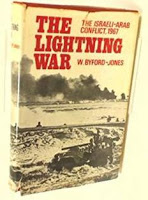
That is the tale that Quaestor, a journalist with a dramatic flair, preserved for posterity in a newspaper (likely the Express and Star, although this is not made clear in the West Mercia Police files). The question is… how much of what he said is actually accurate? Journalists generally tend to take a bit of poetic license with the facts in order to “make a good story”. What sort of a journalist/writer was Quaestor?
As it turns out, Wilfred Byford-Jones was a man of many talents: author, soldier and journalist. His published books span the 1930s to the mid 1960s and cover such varied topics as Middle Eastern conflicts, the liberation of Greece, Midlands stories, travelogues, oil production, and the Holy Land. Having never read any of Byford-Jones’ books, it is difficult to determine how accurate and well-researched they were. In 1946, the Spectator Archive published a review of “The Resisting Greeks” and noted that it was descriptive and unprejudiced and based on Byford-Jones’ own experiences in Greece. On the other hand, a 1967 Kirkus Review of Quest in the Holy Land, concluded that “As Biblical scholarship, the work is uninformed. As report of a journey, entertaining and instructive.” Based on my review of Quaestor’s articles on the Hagley Wood murder, I would suggest that a similar assessment can be leveled against Byford-Jones. His articles are entertaining and descriptive but not all that accurate or well informed. Quaestor’s account of the meeting with Anna of Claverley, and the tale that she told is quite fantastic, but how much is fact and how much is fancy?
Police Statement by Una Hainsworth
Luckily, the police took a statement from Una Hainsworth, one that she signed as being accurate and truthful. Although it is unclear when this statement was made to police, other documents in the same file would suggest it took place in December 1953. The statement reads as follows:
Name: Una Ella Hainsworth
Address: Four Acres, Long Common, Claverley.
STATES:
I was married to Jack Mossop in 1932 and we went to live at the Bridge House, Wombourne. At that time he was studying to be a surveyor. The only child of our marriage was born in 1932 and he was christened Julian and at the present time, he is somewhere in America.
My husband joined the A.S.T. in 1937 as a Pilot Officer and was stationed at Hamble, near Southampton.
In 1938 he commenced work for the Armstrong Siddeley Works Coventry and subsequently he went to work at the Standard Aero Works at Coventry (Banner Lane).
It was in 1940 that a man named ‘VAN RALT’ came to our house No. 39 Barrow Road, Kenilworth. I believe this man was Dutch and as far as I know he had no particular job, and I have a suspicion that he was engaged on some work that he did not wish to talk about, but in my opinion it might have been that he was a spy for he had plenty of money and there were times that my husband appeared to have plenty of money after meeting him.
It was either in March or April, 1941 that my husband came home and was noticeably white and agitated. This was at about 1 a.m. in the morning and he asked me for a drink. I made a comment that I thought he had had enough as he had been out all day but I gave him a drink. He then said he had been to the Lyttleton Arms with ‘VAN RALT’ and the ‘Dutch piece’ and that she had got awkward. My husband was driving the car, which belonged to ‘VAN RALT’, she got in beside him, ‘VAN RALT’ was in the back and then she fell over towards my husband, and he said to ‘VAN RALT’ that she had passed out. ‘VAN RALT’ told him where to drive to and they went to a wood, stuck her in a hollow tree. ‘VAN RALT’ said she would come to her senses the following morning, and as far as I know, my husband came home. He came home in ‘VAN RALT’S’ car which was a Rover.
I lived at Kenilworth until December 1941 and between April and December, my husband appeared very jumpy and it was noticeable that he had more drink than usual, and appeared to have more money to spend. He was nearly always away from work and this led to my suspicion that in some way, he was obtaining money and may have been meeting ‘VAN RALT’. I should mention that my husband had an old Standard Car of his own and he used to go off for days on end and I did not know where he was.
When I left my husband in December 1941 I went to Henley in Arden, and we lived there for ten years. We lived at Nuthurst House, Shrewley, near Henley in Arden, and we finally returned in 1951 to Kenilworth and came to our present address in August, 1953.
I saw my first husband Jack MOSSOP at Kenilworth on three occasions after I was forced to leave him in December 1941 and tried to get my possessions including furniture from the house and on one of these occasions, it would be the last time I saw him, he told me what I thought at first, was a further story to put me off and it was as follows: – That he thought he was losing his mind as he kept seeing the woman in the tree and she was leering at him. He held his head in his hands and said “it is getting on my nerves, I am going crazy”. It was about June 1942 when I heard that he had been taken to the Mental Hospital at Stafford where he died in August 1942. I was not informed of his death at the time and I did not attend the funeral because of this. The first I knew was when my present husband told me that an application had been made at the works claiming money that was due to him and sending a doctor’s certificate.
I had no knowledge whatever of the Hagley Murder until an article appeared in the Express and Star newspaper, neither had I read anything before which could in any way be connected with the incident I have told you about. I have not discussed the matter with anyone and it was not until I was reading the details and bearing in mind the possible date when the woman met her death that I, in any way, connected this with my husband’s statement to me in March or April, 1941, and because of the articles referring to witchcraft etc., I decided in the first place to write a letter and sign it ‘Anna’. I put sufficient clues in the letter which should have helped to have identified me and it was only because of a subsequent appeal in the newspaper and because I felt I ought to say what I know of this matter that I decided to arrange to meet you. I cannot add anything further and because I am now married again with three small children I hope that what I have said to you will only be used to aid the course of justice and it is this which has prompted me to take the action I have. I was not treated too well by my husband and do not wish in any way to rake up the past but if what I have told you will help you in this matter, then the foregoing statement has been made by me voluntarily and with that end in view.
I, of course, have no proof, that what I have told you now is the truth, but bearing in mind my husband’s condition and what he said to me at the time, I have done my best to recall it to help in the enquiry.
(signed) Una Hainsworth
No mention of trapeze artists… no mention of munitions locations passed on to suspicious folk… no mention of a Dutch woman who arrived illegally in 1941… no mention of a second visit to Hagley Wood… no mention of murder. Rather disappointing in fact when one compares it with Quaestor’s fantastic recreation from 1958.
Police Notes on Una Hainsworth
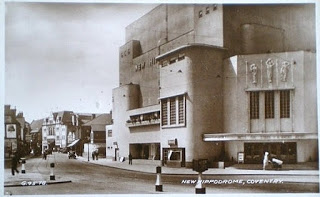
There are, however, some handwritten police notes which add a little bit of extra information to the official typewritten statement of Una Hainsworth. Some of the notes match information in the Quaestor article from 1958. The notes are rather cryptic in places and generally point form, rather than complete sentences. Only the last item noted below has a date associated with it and while the green pen colour, paper and handwriting are all the same, it might be a bit of a stretch to assume that all of the notes were written on the same day. I am including only the notes that are relevant to the espionage theory.
- met Van Ralt/Raalt twice in 1940 – did not work as far as she knows – plenty of money – Rover car which her husband used to drive
- Coventry Hippodrome – man stage name Frack appeared there in 1938
- Stayed at back house on left in Grosvenor R. Coventry – was a boarding house mile from theatre – after Mossop stayed at the house
- finally left her husband Mossop in 13 Dec 1941 – he remained at Barrow Road, Kenilworth – fond of women. Women clothes in house. He was certified insane in June 1942.
- Mossop was reared by his mother’s mother – grandmother reared.
- December 28, 1953 – Enquiries with Insp Morgan, Kenilworth reveal that Una Hainsworth alias Anna is well known and when she left Kenilworth she was in debt to all and sundry and they would like to get their hands on her.
Summary
These then are the facts that we have. Much as Quaestor has a flair for the dramatic, I’m not entirely sure that we can rely on him for facts. It would appear that he is the source of the claim that “MI5 was brought into the case”. At this point, having scanned all of the West Mercia Police files, I have found no indication that MI5 was involved. The police summary of the case, compiled in 2005, and accompanying the files released to the Worcestershire Archives also makes no mention of MI5’s involvement. Despite the fact that many people/blogs/articles/stories have repeatedly stated that MI5 became involved after Una/Anna shared her information, no concrete reference to an MI5 case file has ever been produced. To date, it would appear that IF MI5 was involved (a very big “if”), then those files have not yet been released to the National Archives. All we have to go on is Quaestor’s assertion which, given his ability to stretch the truth in other ways, might be a bit of a leap of faith.
Una’s statement and the police notes (in green ink) have left us with a few other questions:
- Van Raalt – was there such a person? What did the police discover about him?
- Jack Mossop – various rumours state that he was an officer, wore an RAF uniform, died of an overdose at the insane asylum, etc. What is truth? What is fiction?
- Julian Mossop – the son of Una and Jack – what became of him? Why is he listed in the West Mercia Police files as a “possible suspect”?
- Frack – who the heck is Frack? The trapeze artist? Did the police track down any information?
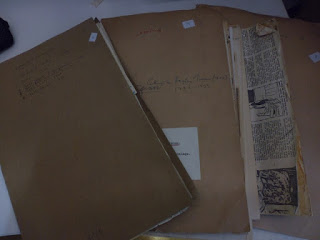
(Worcestershire Archives)
My own interest in this case lies in the direction of espionage and the manner in which Clara Bauerle has been conscripted as a possible victim. The story that Una tells, and her suspicions of espionage, seem to be at the root of the rumours that swirl around a “West Midlands espionage ring”. In upcoming blog posts, I plan to tackle the four questions/characters noted above with reference to the West Mercia Police files on the case. Eventually, we will address the issue of a West Midlands espionage ring.
Sources
The West Mercia Police files were released to the Worcestershire Archives and made available in 2016. The individual pieces of paper in each of the files were scanned in the order that they came out of the boxes and files. The jpg images are simply numbered sequentially, sometimes in batches/bunches, sometimes not. I have stuck with their system and reference it below. It is not clear why File 4 has a title of “Possible Victim Una Hainsworth”.
Worcestershire Archives – West Mercia Police files – Original Documents:
- Plastic Wallets – Anna’s Letter – page 3b & 3a – Anna’s first letter to Quaestor – Nov 1953
- Plastic Wallets – Anna’s Letter – page 4c & 4b – Anna’s second letter to Quaestor – Dec 1953
- File 4 – Possible Victim Una Hainsworth – pages 3a-3f – handwritten police notes (green ink)
- File 4 – Possible Victim Una Hainsworth – pages 4a & 4b – Una’s statement to police (Dec 1953)
- File 9 – Press Cuttings 1943-1993 – Item 29 – 16 January 1958 newspaper article by Quaestor – newspaper is not named and title is truncated: “Kinver Inn Meeting sh… on mystery of… Bella” (Likely was something along the lines of “Kinver Inn meeting sheds light on mystery of Bella”.
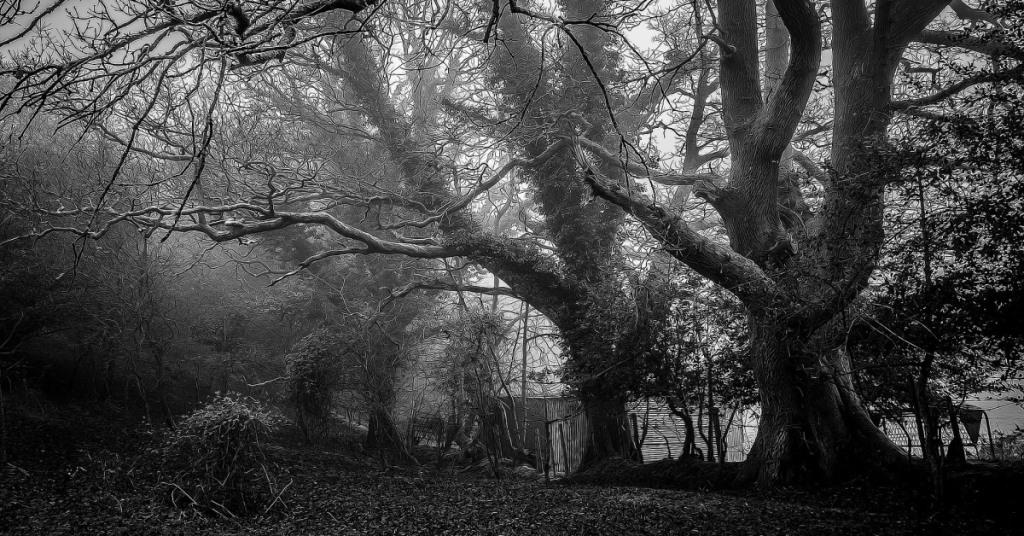
A quick search on Free BMD shows one Una Mossop, maiden name Abel.
A search for children with the surname Mossop, mother's maiden name Abel shows a Julian M A Mossop born in 1932 in Wolverhampton and a sister Jill K Mossop born in 1942, though I am inclined to think the latter was not the daughter of Jack Mossop.
All children born to a marriage are usually registered under the name of the husband and he is assumed to be the father (this has been a bone of contention in surrogacy cases where the surrogate is married and the husband is not the biological father of the child carried by the surrogate.
As per Una's statement she seems not to have been in contact with Jack in 1942 and learned later that he had died. Interesting stuff and can't wait to see what you dig up.
I'm also unsure as to why a 10 year old (Julian would have been 10/11 in 1932would be considered a suspect and be somewhere in America!)
Thanks Ella, it is interesting stuff for sure. I'm working on tracking Julian in the USA.
I'm curious as to how Julian ended up in America, too.
Just had a look at Ancestry and Jill K. Mossop. That is certainly a tantalizing lead, particularly as the mother's maiden name is Abel… birth in early 1942… conception 9 months earlier. It could be…
I am currently researching a full-length book on the subject and find these comments to be of great interest. I would add that a lot of the known protagonists seem to be habitual liars! Byford-Jones had his own agenda and knew Una Hainsworth (Mossop) – although just how well is open to question. I think it highly likely that Byford-Jones put Una up to writing the letter, and don't believe for a minute that she was unaware of the case until reading about it much later in the papers. I don't believe that the case had anything to do with witchcraft, and that any spying connection was tangental. Despite my views on Una, I think it quite likely that her late husband may have been involved. I've come across Jill K Mossop before and think that she may be significant. Short of Jack's brother Louis having a relationship with a relative of Una (of which I can't find any evidence), the timing suggests that Jill could be Una's daughter by either Jack Mossop or Hainsworth. Una maintains that she had three children by Hainsworth, but a fourth could have been raised by them – or farmed out to a relative, as was Julian. I'm looking at the possibility that Una may have agreed to keep a secret in return for her daughter being taken care of – but then reneged for the money that was available for selling her story. It's early days though..
PS – Julian Mossop, after being involved in petty crime, took a job as a chef in London with the American Embassy. It was because of contacts here that he ended up living in the USA.
Hi Keith – thanks for the long comment. Sorry for the delay in posting/moderating and then responding. Blogger had some of the comments squirreled away and I just found them now. It's definitely a complicated story!
Pingback: “Who put Bella in the Wych Elm?” – Il mistero dello scheletro trovato in un albero – Query Online